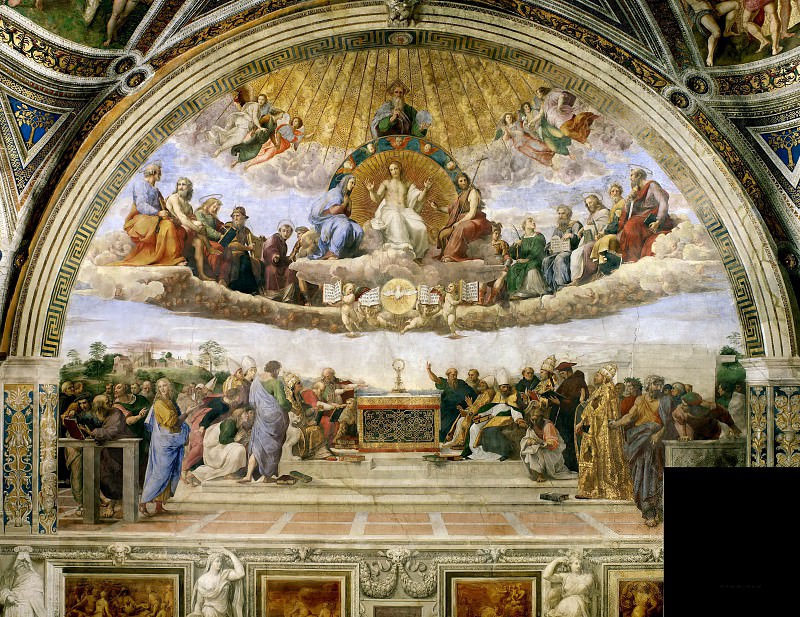Stanza della Segnatura: Disputation of the Holy Sacrament Raphael (1483-1520)
Raphael – Stanza della Segnatura: Disputation of the Holy Sacrament
Edit attribution
Download full size: 4200×3239 px (4,9 Mb)
Painter: Raphael
Location: Vatican Museums (fresco) (Musei Vaticani (murales)), Vatican.
The painter Raphael was known for his work from his youth. As an aspiring artist, he was invited to a prestigious studio located in Rome. During the Renaissance, Raphael was one of those who made a special contribution to its development. The painting "Dispute" decorated one of the great monasteries. The action in the painting unfolds between two realms: the earthly and the heavenly. From above, a holy trinity descends to the people: God, his son and the holy spirit.
Description of Raphael Santi’s "Dispute" fresco
The painter Raphael was known for his work from his youth. As an aspiring artist, he was invited to a prestigious studio located in Rome. During the Renaissance, Raphael was one of those who made a special contribution to its development. The painting "Dispute" decorated one of the great monasteries.
The action in the painting unfolds between two realms: the earthly and the heavenly. From above, a holy trinity descends to the people: God, his son and the holy spirit. Jesus Christ is seen seated on the throne, with his baptist and his mother seated on either side of him.
Then on the sides are all the Gospel prophets. These include Peter, John, the Evangelist, and others. The ungodly are in a serene state, staring down at the people cowering below. It seems as if their movements can be seen. Confident and unhurried.
At the bottom, the artist presents a kingdom of people who stand in anticipation of the deity’s descent from heaven. In the middle is an altar with various gifts on it.
The representatives of the earthly kingdom are priests of the Roman Catholic Church. Besides them near the altar are other well-known representatives of Christianity. They are impatiently waiting for the Holy Trinity to come down to earth and appreciate the earthly gifts. But in the meantime, there is a dispute among the representatives of the earthly kingdom over the gifts. This was the title for the painting.
The entire composition was placed on the semicircular part of the dome. It served perfectly for the complete unfolding of Raphael’s creation. It especially contributed to the celestial vault depicted in the painting. It turned out to be realistic. It seems as if instead of a dome at the top there really are real clouds, and from them the holy trinity descends into the monastery.
The peculiarity of this composition is the church under construction, depicted by Raphael at the side. The artist thus demonstrated the future cathedral of St. Peter, which at the time of the work on the image was in the initial stage of construction.
Кому понравилось
Пожалуйста, подождите
На эту операцию может потребоваться несколько секунд.
Информация появится в новом окне,
если открытие новых окон не запрещено в настройках вашего браузера.
You need to login
Для работы с коллекциями – пожалуйста, войдите в аккаунт (open in new window).




















COMMENTS: 1 Ответы
Диспут о чем? О "предмете ничтожном.. "
Такой высокий художественный талант, да к вечным проблемам приложить бы... Только два-три раза (не больше) за свою карьеру Рафаэль поднимался до вечного. Жаль, что так мало.
You cannot comment Why?
In the celestial sphere, we see a divine council. At the apex, God the Father is depicted with rays of light emanating from him, symbolizing divine power and presence. Below Him, Christ is shown in glory, flanked by the Virgin Mary and John the Baptist, figures central to Christian theology. Surrounding them are various saints, prophets, and apostles, seated on clouds. The Holy Spirit is represented as a dove, descending towards the terrestrial realm, bridging the divine and the human.
The terrestrial realm is where the disputation takes place. Below the celestial scene, a carefully arranged group of figures are gathered around a central altar. On the altar, the consecrated Host, symbolizing Christs presence, is prominently displayed within a monstrance. This is the focal point of the debate. Clergy, scholars, and theologians from different eras are represented, including Popes, cardinals, and prominent thinkers like St. Thomas Aquinas, St. Augustine, and Dante Alighieri. They are engaged in lively discussion, gesturing and pointing, illustrating the diverse interpretations and profound contemplation surrounding the sacrament. The figures on the left, some holding books, represent those seeking knowledge, while those on the right engage in more direct discourse.
The subtext of this painting lies in Raphaels visual presentation of the Catholic Churchs core doctrines. It asserts the divine truth of the Eucharist as the real presence of Christ. The juxtaposition of the celestial and terrestrial realms emphasizes that this truth is divinely revealed and is the subject of ongoing human inquiry and faith. The fresco advocates for the Church as the authoritative interpreter of these divine mysteries, highlighting the importance of tradition and learned discourse in understanding faith. Its a visual argument for the power of theology and the sacraments in guiding humanity towards salvation.